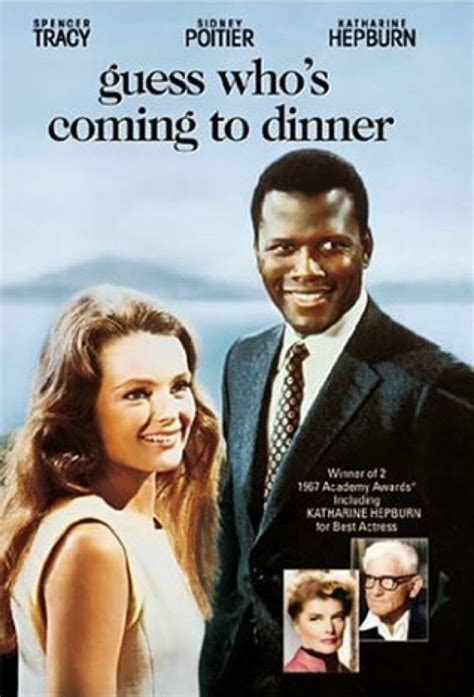Winner of the Fall 2018 StMU History Media Award for
Best Article in the Category of “Year 1968”
The moment of truth was finally at hand for Stanley Kramer. Flashing camera lights could only capture his calm reflection, but underneath his tailored tuxedo, carefully styled hair, and beaming smile, was undeniable nervous anticipation. Tonight he would be in front of all the cameras, instead of instructing from behind them, and everything rode on the outcome of this evening. Stanley Kramer had levied a huge risk in taking on the direction and production of Guess Who’s Coming to Dinner, and as he sat in the audience of the 1968 Academy Awards, he would soon find out whether his gamble had truly paid off. With the country politically fractured and the public divided, could Stanley Kramer realistically expect his movie to win the hearts and minds of the American people?
Guess Who’s Coming to Dinner is the comical drama piece written by William Rose, featuring an upper-class young woman who brings her new fiancé home to meet her parents in order to announce their engagement, after having met each other on a vacation just ten days prior. The older handsome man is quite the catch as an accomplished physician and Nobel Prize candidate. The only problem? He’s a black man intent on marrying their white daughter. The couple cause quite the stir in attempting to overcome interracial bias and be seen as any other couple in love wanting a parent’s blessing for marriage.

Coming together for their ninth film was the universally-loved on-screen couple Spencer Tracy and Katharine Hepburn. The two major actors believed in the project wholeheartedly and agreed to the roles before even setting eyes on the script.1 The natural chemistry between the stars was undeniable, as was the illness rapidly overtaking Spencer Tracy. Almost at once, there was a major hold up in the attempt to start the production. After years of Tracy’s deteriorating health, no insurance company would cover Tracy in his failing condition. What was to become of a project that couldn’t get off the ground? For this movie to stand a chance at the box office, headlining two such profoundly loved actors as Tracy and Hepburn was crucial. An emotional solution was discovered between Stanley Kramer and Katharine Hepburn. They both decided that they would both put their salaries from the film into an escrow account, in the tragic event Spencer Tracy could not continue the movie. With that money as security, another actor could be hired as a last resort to finish the film if need be. With a solution that satisfied the Columbia Pictures production company, filming was finally cleared to begin.2
Obtaining the cast was just the initial problem that Kramer faced. Time was always working against the team, in a race against the clock to finish filming before Tracy became too ill. As a result, the cast members were continuously working with two separate scripts. The original script had the patriarch involved in as many scenes as possible, yet there was always a “back up” script circulating that eliminated Spencer Tracy’s character at any given point.3
Another major obstacle in filming Guess Who’s Coming to Dinner was Sidney Poitier’s intimidation from fellow actors. Despite his own prominent acting career and reputation as a calm and collected professional, Poitier felt humbled to be in the presence of such talent and could never remember his lines. At the time, Spencer Tracy and Katharine Hepburn had both been Hollywood shinning stars for over three decades, and audience members had grown up with these silver screen marvels. Comparatively, Poitier’s acting career had gained more acceptance from his film releases overseas. American audiences had still not fully seen past his African-American ethnicity. This trepidation went on for weeks, frustrating the entire crew with reshoots and wasted film. Finally, Stanley Kramer pulled Sidney Poitier aside for a heart to heart talk in an attempt to get to the bottom of what was causing tempers to rise. The actor simply couldn’t focus in the presence of Tracy and Hepburn. In an attempt to keep Poitier on as a lead character, scenes were then shot as he delivered his lines to two high-back chairs, while stand-in crew delivered his costars’ lines.4
When the movie’s filming began in March 1967, it was still illegal for interracial couples to marry in fourteen states, mostly in the South. If the country could not accept the idea of blacks and whites intermarrying in real life, could Stanley Kramer realistically expect people to be any more agreeable to the idea being portrayed in Hollywood? If the movie was not welcomed by society, future prospects for everyone involved with the project would fall into jeopardy, if not certain ruin.
Coinciding with the film’s production was the Loving v. Virginia Supreme Court case. A white man and a black woman involved in a romantic relationship circumvented the Virginia legislation barring interracial marriages. In 1958, Mildred Jetter and Richard Loving drove to Washington D.C. to say their vows and become legally married. Soon after returning to Virginia, an anonymous tip was given to authorities and the newlyweds were arrested in their home in a late evening police raid. Local prosecution argued that a marriage license from D.C. was not valid in the state of Virginia and the couple were sentenced to a year in prison. The Lovings appealed the judge’s guilty verdict. Monumentally, the Supreme Court ruled in favor of Mr. and Mrs. Loving, just as production on Guess Who’s Coming to Dinner was wrapping up, ruling that marriage is a fundamental human right and effectively ending all anti-miscegenation marriage laws in America.5

Tragedy struck just seventeen days after production concluded, when Spencer Tracy died of a heart attack. His passing gravely affected the cast, and overshadowed any joy of the movie’s release. Katharine Hepburn refused to attend any premiers or award ceremonies, let alone see the final movie cut, as the memories of her long-time costar were just too painful.6
Reviews of the movie from audiences and critics alike received an initial mixed response. The initial estimation was one of low attendance of Caucasians, especially in the Southern states. After all, new laws or not, long-standing socially-formed opinions take time to overcome. However, this was not the case, and never again was the race of a lead character a factor in projecting audience film acceptance.7 Written reviews were not so kind. Sidney Poitier took the brunt of criticism, not simply for being an African-American actor, but for being “too perfect” and “too white” in his role portraying a Nobel Prize nominated doctor.8
Stanley Kramer fiercely defended Sidney Poitier’s performance and explained that every character was meant to portray model social and moral perfection; only then could the sole protest land at the couple’s racial divides.9 In an attempt to clarify his intentions with the film, Kramer undertook a nine-university tour to discuss the political and social controversy. For all his efforts, Kramer was met by indifference at best and death threats at worst! The movie seemed to be caught in between an atmosphere of younger students who did not see interracial relationships as controversial, and the older generation who wanted to keep the races forever separate.10
The lights now dimmed on the Academy Awards audience, and the announcements began as everyone took their seats. Spencer Tracy’s widow was in attendance to hear her husband be nominated as Best Actor one final time. Katharine Hepburn was at home still mourning, and the magic of the evening was muted by sadness. But for all the hardships, when Stanley Kramer heard his name read as a nominee for Best Picture, he knew in his heart that the trials and bitter-sweet tribulations were all worth it in the end. Stanley Kramer did not win the award for Best Picture that night. But he had produced the most emotionally important movie of his career, directed award-winning performances, and showed all the Hollywood elite that they did not need to be afraid to take a leap of faith in making controversial films.

When all was said and done, Guess Who’s Coming to Dinner became an international box office hit grossing over $70,000,000 and nominated for twenty-two different awards. In 2017, the movie title was entered into the National Film Registry by the Library of Congress for being culturally and historically significant.11
- Donald Spoto, Stanley Kramer: Film Maker (Putnam, 1978), 280. ↵
- James Curtis, Spencer Tracy: A Biography (London: Hutchinson, 2011), 839. ↵
- Bill Davidson, Spencer Tracy, Tragic Idol (Dutton Adult, 1988), 206. ↵
- Sidney Poitier, This Life (Alfred A Knopf, Inc, 1980), 286. ↵
- Loving v. Virginia, 388 US (1967); Maria Mancha, “The Love Story of the Lovings,” StMU History Media. https://www.stmuhistorymedia.org/the-love-story-of-the-lovings, (accessed Oct 4, 2018). ↵
- Katharine Hepburn, Me: Stories of my Life (Alfred A Knopf, Inc, 1991), 402. ↵
- Mark Harris, Pictures at a Revolution: Five Movies and the Birth of the New Hollywood (Penguin Press, 2008), 374. ↵
- Dolores R. Townek, Letter to the Editor, Ebony, June 1968. ↵
- Christopher Andersen, An Affair to Remember: The Remarkable Love Story of Katharine Hepburn and Spencer Tracy (William Morrow and Co, 1997), 295. ↵
- Mark Harris, Pictures at a Revolution: Five Movies and the Birth of the New Hollywood (Penguin Press, 2008), 398. ↵
- Sheryl Cannady, “2017 National Film Registry is More Than a ‘Field of Dreams,'” Library of Congress, December 13,2017, https://www.loc.gov/item/prn-17-178/. ↵



115 comments
D'vaughn Duran
Great information you had for the reader. I liked how you had videos and described interracial marriage at the time frame as not normal. I think this is a great topic because this is the first I every heard of this movie. You did a great job of collecting information and it inspires people to watch the movie because I am invested in actually seeing the movie by your article.
Nnamdi Onwuzurike
The information I read about this movie was interesting. It’s insane that interracial marriage was illegal and I t is incredible how far society has come in fifty years, and this movie has contributed to some of that change. Since it encourages tolerance and change, this movie ranks among the most significant works of American cinema. Knowing that Kramer received threats of death following the production of this film isn’t very surprising
Ian Poll
It really seems that the movie was released at the right place and time it needed to. Everything lined up in timing to the release of the movie and it probably wouldn’t have been such a success to be nominated or box office revenue if it was released before the court case of the Loving’s, but it still would have made an impact on America either way.
Alexandra Ballard
I loved this article! I didn’t know interracial relationships were portrayed on television so early! I think it’s to be expected that there would be mixed emotions, whether those emotions are valid is in question. I’m glad that there has been representation for so long. As someone with parents in an interracial marriage it’s a norm to me but still today, so many people view these marriages as “exotic” and I find that strange.
Veronica Lopez
Congratulations on winning an award for “Best Article in the Category of the Year ‘1968’! Your article really showed me a new side of theater that I’ve never seen. I honestly found it surprising how they would make a movie with an interracial couple during 1967. Keep in mind that during this time, racism was still going on. It all seemed risky. Overall, this movie was controversial for it’s time and it might’ve made people question their perspective on African Americans.
Amelie Rivas-Berlanga
Great article! I can not imagine how nerve wracking it must have been to produce this movie, especially since so many states still had not accepted interracial couples. I had never heard of the movie Guess Who’s Coming to Dinner, but this article is definitely making me want to watch it. It is a shame that the film did not win the award for Best Picture. I loved the inclusion of the video, it was a great scene to include.
Natalia Ramirez
Congratulations on your award for “Best Article in the Category of Year 1968.” This was a great article! I had never heard of this movie or of Stanley Kramer, but he is definitely someone who should be remembered as he was very brave for producing a film that was very controversial at the time. I also like the video you included. Very interesting!
Aidan Farrell
Very good job on this article, Anissa. I did not know much about this movie, much less the history and significance behind it, but your article did a good job with helping me learn about this revolutionary movie. I did not realize there was so much trouble getting this movie made, but it is honestly great that it paid off in the end. Well done.
Andrea Degollado
Very well written article! Honestly before clicking this article I had no clue as to what this article would be about i didn’t even know there was a move called Guess Who’s Coming to Dinner. This article did a great job in informing me and it was honestly a very interesting article and I plan to watch the movie. I think this article was truly amazing and it promotes the idea of challenging societies view. Great article, good job!
Charli Delmonico
I had no idea that filming this project took so much work and had so much on the line! I also can’t believe how the actors were willing to put money away just in case the crew needed to hire someone else in the event of Spencer Tracy dying due to declining health problems. This story is so interesting and informative, and I thought it was really well-written.